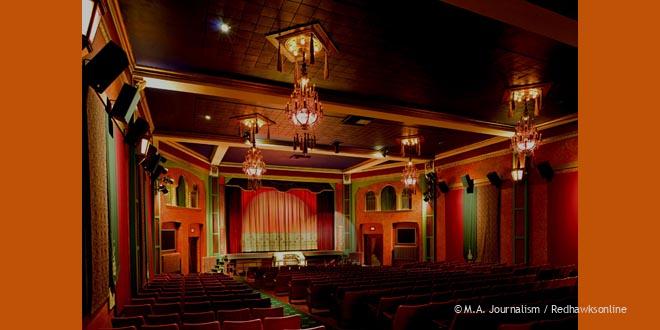In the era of Netflix and megaplexes, an independent cinema in Columbia Heights gives audiences a classic moviegoing experience
Tom Letness dimmed the lights hanging from the movie theater’s chandeliers and waited for the audience to quiet. He pushed a small DVD labelled “Spotlight, 2015” into a disk drive and flicked a switch hidden on the side of a large digital movie projector. The first thing I noticed about this movie was that no trailers played before it.
“I just don’t do that,” Letness said, “I know what these people came here for, why make them wait?”
After looking over the projector a couple more times, he grabbed two chairs that were sitting next to a small window with a view into the theater, placed them in between a couple of large 35mm film projectors and motioned for me sit in a chair across from him.
Letness has owned the Heights Theater in Columbia Heights, a small, one-screen movie cinema built in 1926, for 18 years. He saved it from being condemned by the city by buying it with money he earned from managing the Dairy Queen located next door to it.
He has now dedicated his entire life to the theater and has already restored it, put in a new pipe organ, fixed the two film projectors and installed a new digital one.
What was once considered a dying theater has become a celebrated piece of cultural history within Columbia Heights (though throughout the Twin Cities it may be an overlooked treasure). Though the small suburban movie theater thrives in its new found revival, it happens to be a unique situation, as many other small theaters across the nation have had to shut down. The National Association of Theater Owners (NATO) has placed the blame on internet streaming services like Amazon and Netflix, and claims that such companies remove people’s want to leave their homes to view movies, and consequently kills cinemas across America.
Minnehaha film teacher and Theatre director Nicholas Freeman believes that the reason many theaters are shutting down is an issue made by feasibility.
“Do I want to drop $100 for me and a family of four to go to movie theater, or do I want to get some good chinese takeout, pay $4 for a movie on-demand, and cuddle up on the couch with my kids? I love to go to the local AMC, buy a bucket of popcorn,and watch a movie, but it’s easier to just watch something on Netflix.”
However Letness disagrees and happens to believe that the decline in movie theaters is due to an oversaturation of the market.
“It’s not even worth my time to try and outdo the AMC in Roseville. It can’t be done. They can have eight or nine of their 20 screens playing the same movie at the same time, and I have only one screen that can play one movie at one time. A lot of these small theaters end up closing because they can’t keep up with these megaplexes.”
A large centralization of the market could be one of the causes of the nationwide theater shutdowns.
NATO studies show that in the last 20 years the number of theaters in America has gone from 7000 to 5000, but at the same time the number of screens per theater has gone up from 20,000 to 40,000 in just the same time. Large corporations such as AMC and Regal often buyout smaller theaters to reduce business around their megaplexes, which causes a saturation of the market.
Though both internet streaming and megaplexes have an effect on the industry, Letness and Freeman agree that the business will survive due to its deep roots in American tradition. As Letness compares, “People have kitchens, but still go out to eat. The movie theater will never cease to exist, because it’s the experience people look for. People come for the popcorn, the soda, and the stillness of the theater as the screen begins to move. Streaming is a neutral force on theaters, and at the end of the day, it could even install a love for movies in a new generation.”
As the movie credits slowly came to an end, Letness and I left the projection room and entered the main lobby, and it was in there I saw my proof that movies would live on.
A full lobby was waiting to go inside for a screening of Shall We Dance, a 1937 musical starring Fred Astaire and Ginger Rogers. Letness went to the counter and got concessions for the crowd, and soon afterwards went back upstairs to the projector room to ready the film for another cinema full of people, all wanting to have the same magical experience that Letness and the Heights Theater have provided to audiences for the last 18 years.

